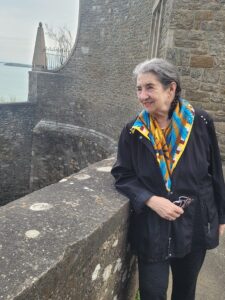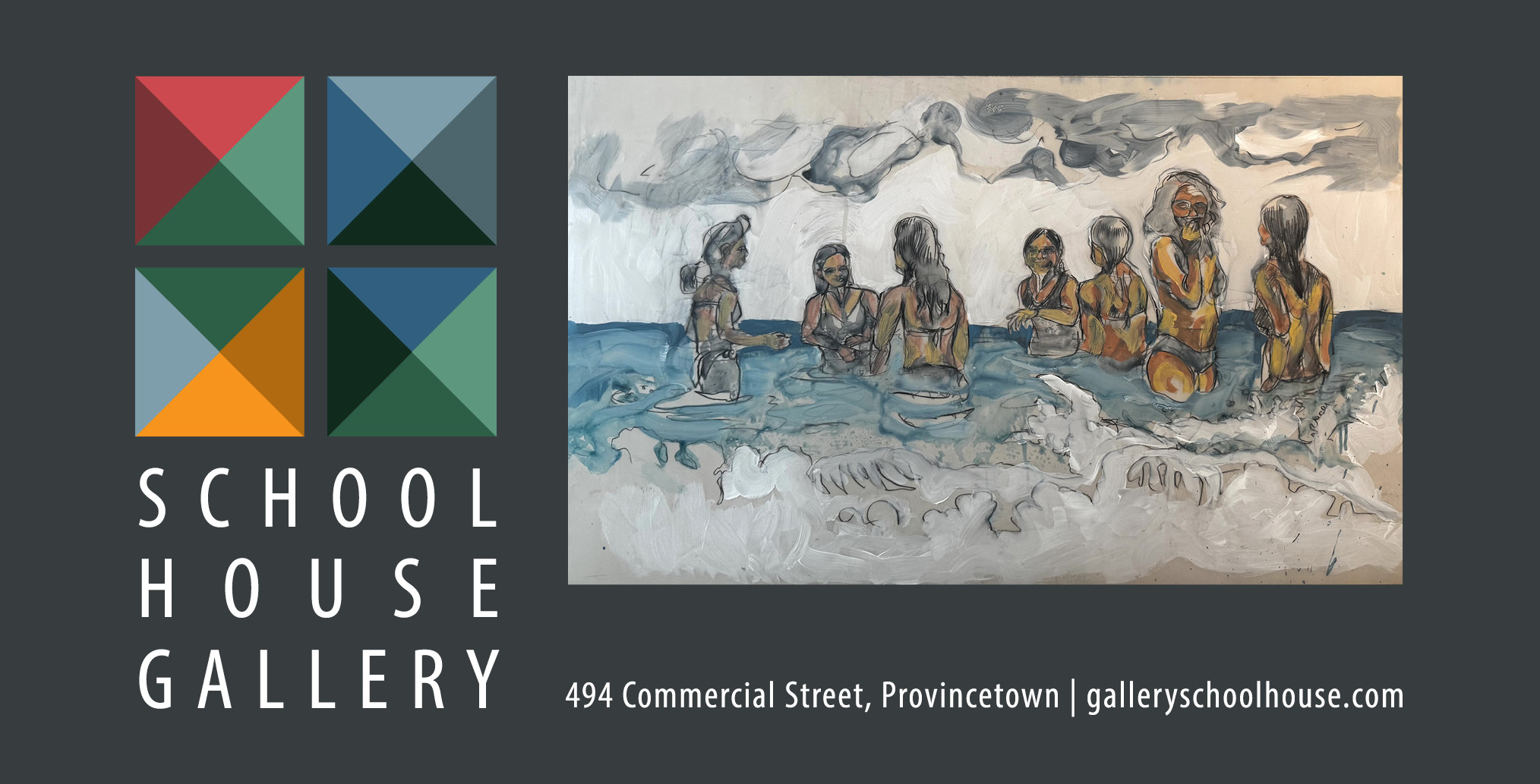As a child, reared close to the Atlantic Ocean in Brittany, the westernmost region of France, Monique Brunet-Weinmann excelled at reciting poetry from memory. “Pretty soon,” she says, “I started to write.” After many years, Brunet-Weinmann has published her first book of poetry. Exil (“Exile”) was released in October 2024 by the French publisher Éditions Balzac.

“Poetry is rhythm and sound,” says Brunet-Weinmann. She’ll work at a poem until its consonants punch and kick, or until its languid vowels flow like water. In the living room of her home on Aaron Rich Road in South Wellfleet, where she and her husband have spent summers since 1979, she reads aloud a sentence from the book in which she mentions Sable Island in Nova Scotia, a place populated only by wild horses. Her consonants drum like hoofbeats.
The first part of Exil, which is entirely in French, has to do with a longing for Brittany: all the poems are named for small towns there. The second part consists of memories of Paris, where Brunet-Weinmann studied for her Ph.D. in literature at Paris-X (now known at Paris Nanterre University). The third part of the book consists of three long poems, each one a rumination inspired by “very strange, very precise” nightmares she’d had in Paris.
Brunet-Weinmann thinks of those nightmares and the resulting poems as “premonitions” of a coming revolution in Paris. Almost every poem in Exil was written in Paris in 1967, a year before France’s “May 68,” when the city was teeming with revolutionaries and on the brink of societal dysfunction. Brunet-Weinmann remembers it feeling like “the end of a world.”
“Cahoon Hollow Beach” is the final poem in Brunet-Weinmann’s book. It’s an abstract, untethered survey of the landscape. It has a similar vantage point as the other two apocalyptic poems at the end of Exil. All three are visions from above, Brunet-Weinmann says: bird’s-eye views of the world where the viewer is far from grounded and seemingly unable to look away from luminous ruin.
“Cahoon Hollow Beach” was previously published in 1975 in Liberté under the title “Holocauste.” That title referred not to the Holocaust as an event, she says, but rather to the threat posed by the Cold War: “It was a very anguishing time,” says Brunet-Weinmann. “With the number of bombs, you could have destroyed the whole Earth.” The word “Holocauste” was meant to evoke the horrifying notion that “an incalculable number of people could disappear.”
In Exil, the poem has been re-titled to better fit Brunet-Weinmann’s vision for her book: one that travels from Brittany to Wellfleet. But the text is unaltered from the 1975 version.
The poem’s perspective seems to be from the top of tall sand dunes, sloping down to the Atlantic Ocean. Reading it now, Brunet-Weinmann says she imagines the cliff-like dunes of White Crest Beach, but she preferred the name “Cahoon Hollow” for its sonority. The dunes are like the tiers surrounding an amphitheater. “They make a theater above the ocean,” she says. Far below, the world of the poem — visions of skeletal remnants of ancient fish, the tangible fear and anguish of doomed species — occurs like a dreamy, fantastic, horrible play.
The feeling of the poem is more universal than specific. Cahoon Hollow Beach could just as likely be a seaside cliff in Brittany.
Allusions to ancient literature underscore this aerial vantage point. “We were on the edge ready to sacrifice,” writes Brunet-Weinmann in the ninth line of the poem. “It’s theater,” she explains: the sentence is a statement like that of a Greek chorus in an ancient play. It’s meant to ring untrue, she says — a proclamation of false nobility, disguising sick fear.
In the penultimate stanza, Brunet-Weinmann writes of “Le Transi,” late-Gothic sculptures depicting bodies in the throes of decomposition, and “lava mummies,” tortured bodies preserved by volcanic ash. She writes of “salt statues,” referring to the story in Genesis of Lot’s wife, who turns to look back at the burning city of Sodom and, for the forbidden act, turns into a pillar of salt. In some ways, “Cahoon Hollow Beach,” with its language rich with anguish, is a response to the “looking taboo” — that motif in mythology and folklore that involves dire consequences for the action of looking at something that isn’t meant to be seen.
The poem is an unsettling end to a book that is ultimately a story of migration. In 1968, Brunet-Weinmann left Paris with her husband, Heinz Weinmann, partly because they feared for their safety and partly because the city was “too tight, too noisy, too crazy,” she says. She hated the underground transit system. “I was like a mouse in a cage.”
Brunet-Weinmann felt exiled as a French woman married to a German man. She was looking for a job as a professor, but “you had to be French to teach in France and German to teach in Germany,” she says.
In 1969, the couple settled in Montreal. “We were young, we had no possessions,” she says. “When you are free like that, you can move.” Brunet-Weinmann completed a master’s degree in art history at the University of Montreal and taught at McGill University for a few years. In 1974, she started a decades-long career as an art critic for the magazines Vie des Arts and Parcours des Arts.
But Brunet-Weinmann missed the sea. She and Weinmann camped along the coast in Nova Scotia, Maine, and Cape Cod. In 1979, they bought their house in South Wellfleet. Wellfleet reminds Brunet-Weinmann of Brittany with its stark shore and frigid gusts.
Everyone has their element, says Brunet-Weinmann. She isn’t often inspired to write poetry in Quebec because “snow is not my element.” Instead, she says, she’s a creature of “the water and especially the wind.”
But water and wind aren’t mandatory preconditions for poetry — she just needs to feel something profound, “deep in my soul,” she says. “I don’t write for nothing.”
Cahoon Hollow Beach
By Monique Brunet-Weinmann
J’ai vécu l’heure du dernier rivage
L’aurore déjà était en deuil du monde
et la mer morte
décharnée de ses sables souples
la plage
échafaudait un escalier de dalles sonores
Nul vent nul movement nulle odeur
pas de fleurs étoilées Pulsant dans les rocailles
« Nous étions sur ces bords prêts pour le sacrifice »
Aainsi se parlait la mémoire
rétive aux lueurs de révolte
lumineuse enseigne où seule admise
clignotait cette fausse nouvelle
Toutes les pierres de seiches
accumulées depuis des millénaires
crissaient sous les pas comme les coquillages
au temps des pêches miraculeuses
Le Transi était là en squelette
et les Statues de sel
et les Momies de lave
et nous n’aurions ni Danse macabre
ni Jugement dernier
Des fossiles calcaires froissaient sur les falaises
le satin broché des ramures de givre
et les carcasses creusaient des grottes de stuc aride
dans l’attente et l’angoisse tangibles.
—–
I lived through the hour of the last shore
the dawn was already in mourning for the world
and the dead sea
stripped of its supple sands
the beach
a staircase scaffolded with slabs of sound
No wind no movement no scent
no starry flowers pulsing among the rocks
“We were on the edge ready to sacrifice”
Thus spoke to itself the memory
resistant to the gleams of revolt
neon sign where only this fake news
flashed repeatedly without end
All the stones of dead squid
accumulated over millennia
crunch underfoot like shells
in the time of miraculous fishing
Le Transi were there in skeleton
and the Salt Statues
and the Lava Mummies
and we would have neither Dance of Death
nor the Last Judgment
The limestone fossils crumpled on the cliffs
the satin brocade of the frosted branches
and the carcasses dug caves of dry stucco
in tangible expectation and anguish.
Translated by Montana Miller



